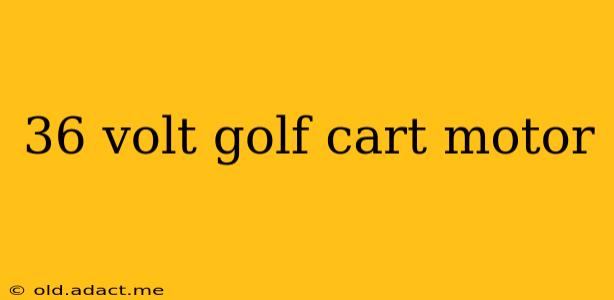Choosing the right motor for your golf cart is crucial for performance and longevity. This guide delves into the world of 36-volt golf cart motors, covering everything from types and specifications to maintenance and troubleshooting. Whether you're looking to upgrade your existing cart or are building a custom one, understanding the nuances of 36-volt motors will help you make an informed decision.
What are the Different Types of 36 Volt Golf Cart Motors?
36-volt golf cart motors primarily fall into two categories: series-wound and permanent magnet DC motors.
-
Series-Wound Motors: These motors are known for their high torque at low speeds, making them ideal for hauling heavy loads uphill. However, they can draw significantly more current, potentially impacting battery life. They are generally less efficient than permanent magnet motors.
-
Permanent Magnet Motors: These offer better efficiency and longer battery life compared to series-wound motors. They provide a consistent torque output across a wider speed range. While they might not have the same raw low-speed torque as series-wound motors, advances in permanent magnet technology are closing this gap.
How Much Horsepower Does a 36 Volt Golf Cart Motor Have?
The horsepower of a 36-volt golf cart motor varies considerably depending on the manufacturer and motor design. You'll typically find motors ranging from approximately 3 horsepower to upwards of 8 horsepower. However, horsepower alone doesn't tell the whole story; torque (rotational force) is equally important, especially when considering hill-climbing ability and carrying capacity. Always check the manufacturer's specifications for the exact horsepower and torque ratings.
What is the Difference Between a 36 Volt and 48 Volt Golf Cart Motor?
The key difference lies in the voltage. A 48-volt system generally provides more power and torque than a 36-volt system. This translates to higher speeds, better hill-climbing capability, and the ability to carry heavier loads. However, 48-volt systems often require more expensive batteries and controllers. The choice depends on your specific needs and budget. A 36-volt system is suitable for lighter loads and flatter terrains, while a 48-volt system offers superior performance in more demanding conditions.
How Long Do 36 Volt Golf Cart Motors Last?
The lifespan of a 36-volt golf cart motor depends on several factors, including usage, maintenance, and operating conditions. With proper maintenance and moderate use, you can expect a well-maintained motor to last for several years, even exceeding a decade in some cases. Factors that shorten lifespan include overheating, overloading, and neglecting routine maintenance.
How Do I Choose the Right 36 Volt Golf Cart Motor for My Needs?
Selecting the right motor requires careful consideration of your specific requirements:
- Terrain: Are you primarily using your golf cart on flat surfaces or do you frequently encounter hills? Hilly terrain necessitates a motor with higher torque.
- Load: How much weight will your golf cart typically carry? Heavier loads demand a motor with greater power and torque capacity.
- Usage: How often and for how long will you be using your golf cart? Intensive use may require a more robust and durable motor.
- Budget: Motor prices vary considerably, so setting a budget is essential.
What are Common Problems with 36 Volt Golf Cart Motors?
Common problems include:
- Overheating: This is often caused by overloading or lack of proper ventilation.
- Brush wear (in brushed motors): Worn brushes reduce motor efficiency and power.
- Controller issues: Problems with the motor controller can severely impact motor performance.
- Wiring problems: Loose or damaged wiring can cause intermittent power or complete motor failure.
Regular maintenance, including cleaning and inspecting the motor and its components, can help prevent many of these issues.
By carefully considering these factors and understanding the different types of 36-volt golf cart motors available, you can choose the perfect motor to power your golf cart efficiently and reliably for years to come. Remember to always consult the manufacturer's specifications and recommendations for optimal performance and lifespan.
